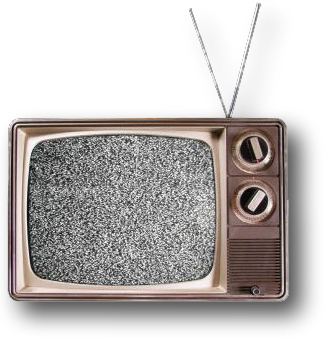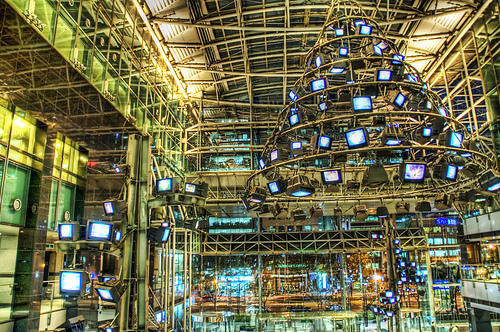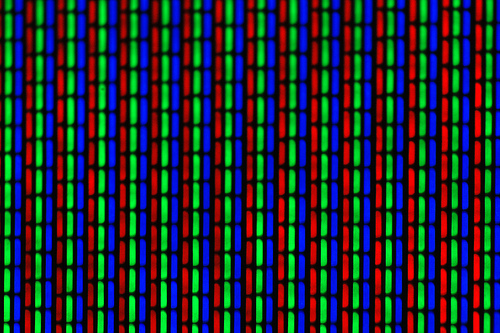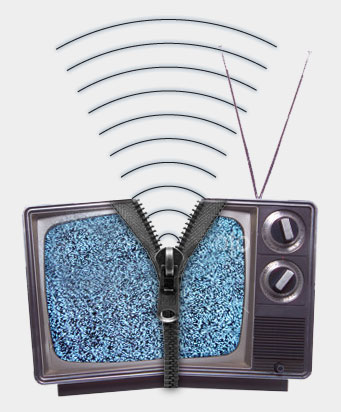Free TV: White Spaces & Broadcast Flag
Patrick Burkart / Texas A&M

This essay looks at the public interest in newly unlicensed “white space” for wireless networking, and also at impending copy protections threatening digital television signals, players, and recorders. The former can open up the distribution bottleneck in the TV business to non-commercial participation, while the latter can narrow it further.
“Interactive” TV is one of the longest-standing harbingers of our entry into the Information Age, and yet most TV viewers have not yet arrived there. Broadband streaming is substituting for TV viewing, with many users taking a large part of their TV diet in the form of YouTube clips, “pirated” or retransmitted live streams, and other sources. These alternative production and distribution channels are undermining the dominance of traditional TV networks, but haven’t yet disrupted them completely. US television broadcasting and multichannel television, as we have known them, are new confronting technology and policy changes that could seriously interrupt “business as usual” after the digital transition of February 2009.
A coalition of commercial and non-commercial petitioners argued in favor of expanding the cyber-commons using the “white spaces” of spectrum available in-between TV broadcasting channels. A surprising vote by an FCC that has appeared as captured by the financial interests of incumbent media systems has freed up the white spaces in between the existing UHF television channels to provide desperately needed, unlicensed spectrum. The decision in November 2008 was unanimously in favor of making available unlicensed broadband spectrum to a new generation of low-power networking and transmission devices (television band devices or “TVBDs”).

That the resources exist in-between licensed digital television channels was a basis for complaints by the NAB, which lobbied against their unlicensed use on claims of potential signal interference. The TV industry’s critics decried these objections as a pretext, and persuaded the FCC to reject the broadcasters’ technical claims. What the NAB didn’t argue publicly was that the white spaces could also be used to create competing programming and advertising markets, under a deregulated environment for ownership and content. Interactive TV for the masses, in other words, could come from new competitors operating from a new technology platform. It could also come from non-commercial and user-generated sources.
During the complicated digital transition, broadcasters have expressed their desire to further restrict the terms of distribution and redistribution of digital programming for interactive TV. The so-called “broadcast flag” initiative is backed by the entertainment industry, by the NAB, and by Microsoft, and justified publicly as a technological solution to the unauthorized re-transmission of digital programming through the Internet and other networks. The broadcast flag carriers want to impose new restrictions on viewers’ TV watching, recording, and playback activities.
The FCC, Free Press, and others have imagined that TVBDs could be exploited by wireless ISPs to provide broadband Internet access through low-power devices (similar in some ways to WiFi, but operating in the 700 Megahertz band). Proponents of the white space deregulation foresee it providing ubiquitous “last mile” broadband Internet connectivity. Yet, it is not unimaginable that an alternative, unlicensed model of “broadcasting,” perhaps similar to “multicasting” on the Internet, could emerge based on TVBDs, in which viewers could select from a choice of live, continuous signals.

Researchers have clearly expressed the fact that physics and engineering have yet to resolve basic technical problems with creating thousands of canopies of local TVBD coverage. But TVBD content will, juridically, exist in a new free speech zone similar to podcasting and Web publishing in the US. TVBD could be deployed under the emergent IPv6 “Internet 2” protocol, which facilitates multicasting, which permits “broadcast” like transmissions across the Internet. Or, it could bypass the Internet, using Internet gateways for long-haul transmission between clusters of local TVBDs. Conceivably, this new kind of service could look and sound like broadcast or multichannel TV, but without TV licensing or content regulations. It could be propagated initially through and between local clusters of interconnected TVBDs.
If these prospects for a more robust vision of interactive TV seem too good to be true, then a quick look at the “broadcast flag” movement serves as a reminder that the contemporary political economy of broadcasting depends more than ever on the enforcement of scarcity-imposing regimes. The TV broadcast flag debate reveals the desire of the entertainment and software industries to introduce usability problems into TV broadcasts, and personal video recorders, where none currently exists. The push to introduce broadcast flag encoders and decoders into the digital media ecosystem expresses the lockdown tendency of the “Celestial Jukebox” in proposed television broadcasting policies. Were it made binding, this change to the encoding standard for digital TV signals would change the international political economy of television by extending the Celestial Jukebox of Internet media regulations to television audiences.

The entertainment industry and broadcasters worked hard to make copy protections for TV signals part of the DTV roll-out in 2009. But the standards for the current generation of HD televisions narrowly escaped new requirements of the broadcast flag, thanks to the DC Circuit court’s ALA v FCC decision of 2005. The Electronic Frontier Foundation wrote at the time, “The court ruled, as we had argued, that the FCC lacked authority to regulate what happens inside your TV or computer once it has received a broadcast signal. The broadcast flag rule [made by the FCC] would have required all signal demodulators to ‘recognize and give effect to’ a broadcast flag, forcing them not to record or output an unencrypted high-def digital signal if the flag were set” (2005). The DC Circuit court of appeals overrode the FCC’s decision to cave to the culture industries, and preserved the ability of innovators to manufacture open hardware, such as MythTV, and innovative new digital television recorders such as Elgato Systems, makers of iMac PVR software. The TV and cable companies, and Microsoft, are likely to try again to impose “voluntary” if not mandatory copy protections on digital programming, media PCs, and PVRs, working through legislative channels. These changes were never requested by TV fans.
Interactive television technology and policy is still emerging, and full of surprises. The November 4, 2008 decision by the FCC is rare, if not unprecedented. The same regulator that had caved into the broadcast flag demands initially, only to be rebuked and reversed by the DC Circuit Court of Appeals, had been assumed by most critics to have been fully “captured” by the incumbent players. Yet, the FCC moved to improve citizen access to media, in a sudden and disruptive way, and even before the market delivered a usable version of the disruptive technology. The regulationist model of broadcasting, which includes the existing system of network oligarchs, a weak regulator in the executive branch of government, and an embrace of DRM among stakeholders, is now faced with competing some day against an alternative “broadcasting” model that is deregulated, ad-hoc, and open to non-commercial, personal, and community production and networking efforts.
Image Credits:
1. Television White Space
2. Television Metropolis
3. The Visible Spectrum
4. White Noise Unlocked
Please feel free to comment.
Thanks for this update, Patrick, I had been following this from afar and this fills in the picture a lot. My main question had been: is the FCC really going to do that?! I guess the answer is yes. Could you comment on the prospects of white space in urban areas? My understanding is that it will be largely if not exclusively a rural service. Also, I’m quite curious to see what institutions move toward that deregulated space, since existing groups – corporate, religious, non-profit – will have the resources to and interest in colonizing it first, and as thoroughly as possible.
Hi Chris,
Good to hear from you. The rural spectrum available is greater than the urban spectrum. I could speculate about who will be the first on the white space frontier in force. Fortunately, the technology for exploiting the white spaces is good at sharing, so in theory, there is a channel out there for everyone who wants one.
Patrick,
I also have a question for you, can this white space then be used by cities for free municipal wi-fi connectivity? I guess I still don’t really get what it is. It’s on TV but allows low-power connectivity but is interactive… help me understand what exactly this is.
Vicki
Dear Vicki –
I have read several sources that indicate that municipalities are interested in turning to this approach for providing Internet connectivity. However, specifics are lacking at this point. There are also many states that still prohibit public entities from providing muni WiFi; I’m not sure if these prohibitions would hold with the white spaces, as well. Let’s hope not.
Best,
Patrick
Ok This Might sound stupid but say this takes off, and is WIDE OPEN TO -0 the scenerio I see in my head from this is alot of people passing opinion without interactrion with the subject. And so the runnaway train so tio speak ? MY INTERESTES IN MIND
Here we are having one of the suitable option setting windows 10 for you to sort out all your hurdles facing while synchronizing windows 10 settings so you may try out this portal which will help you to seize all beneficial information.